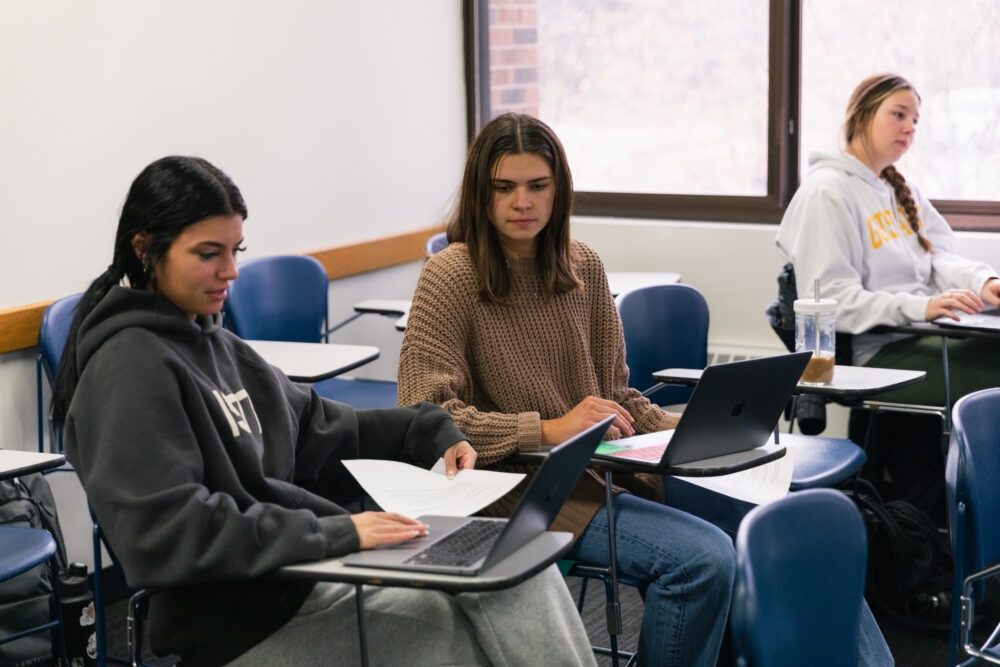
In the wake of Covid, Public Health students have more career opportunities than ever.
Before he started the Public Health minor program at Gustavus, professor Karl Larson was working in Student Affairs in 1991. “I didn’t go into teaching right away,” Larson said. “I got my doctorate in 2001, after about six years [of graduate school], and got my first full-time health teaching position at the University of Southern Indiana. When I was hired into Gustavus, it was initially into the Health Education program, which no longer exists here.”
Larson decided to aim for something more global than the health education arena, and the Public Health minor was born in the fall of 2015. By the spring of 2017, the minor had its first 25 graduates. Between then and now, it has added 104 more.
Public Health gave the College an opportunity to broaden its scope. There are 10-15 different types of courses for Public Health students, who can tailor the program to fit their goals and interests, which ultimately serves the field itself. “Every student takes the four core courses, then the minor is focused in a direction that they generally want,” Larson said. “Public health is extraordinarily broad. You can work in a government agency, in an accounting department, a nonprofit, or provide health education in a separate discipline.”
The primary majors that add the Public Health minor are Biology, Nursing, and Exercise Science. Psychology also contributes a notable amount of students. Public Health allows these students to broaden their major discipline while picking up a useful supplement. “We want to look at the global picture of what people do,” Larson said. “It allows people to serve the discipline that you are working with. And frankly, that doesn’t even include the boots-on-the-ground jobs that people normally associate with public health, such as being an outreach worker or in a nonprofit.”
The oldest saying about Public Health—when people don’t know who you are, that means you’re doing your job really well—might sound a little ominous, particularly in the wake of the Covid pandemic. When that unfolded, many people didn’t realize that public health professionals had been there all along—conducting restaurant inspections, providing immunizations, offering nutritional services for certain population segments, and so on. Now these officials were warning the population about the pandemic and calculating and recommending potential responses. Once the coronavirus began taking lives and shutting everything down, public health found itself in an often-harsh spotlight. But that’s the job. “Any time you deal with an outbreak, there are public health officials at the forefront addressing it,” Larson said. “Epidemiologists guide the recovery process. Every year, when we talk about flu outbreaks, when you hear about the growth of RSV in the U.S. or of monkeypox in Southeast Asia, that’s when people notice public health.”
Covid presented a sudden and stark departure from the field’s typical rhythms. Public health professionals normally do their work quietly, behind all the mechanisms that influence our day-to-day well-being. “I don’t think about my water safety; public health people do,” Larson said. “People don’t think about how a restaurant is following public health protocols, but public health does that work all the time. Only when something goes really wrong do people think about it.”
Given the societal importance of public health, it’s little wonder that Larson welcomes students who have a passion for it. “I find it really exciting when I see that lightbulb go off for a student,” he said. “They start to see the bigger picture, and they start to see the discipline with a renewed passion. They start to see the way that public health functions when you are a professional [in the field].”
This is the best moment for Larson. For anyone in the public health profession, there is nothing more important than helping people lead better, healthier lives, and that’s a calling he values. “When a student finds their path toward [helping people], that means the world to me,” Larson said. “That is why I do what I do. When you watch it happen, and people find out that this is what they want to do, that is pretty cool.”
Larson has been using student feedback to try and expand Gustavus Public Health into a full major, a decision the College administration will ultimately make. “I keep hearing that this is what students want; that keeps me pushing for more,” he said. One factor that could influence such a move is that public health needs more qualified people. “Right now, frankly, the profession is aging a little bit,” Larson said. “We are looking at turning over between 35–45% of the workforce in 2024. Available positions are projected to increase by 15-to-18 percent over the next 10 years.”
Whether it be in community health, epidemiology, or other parts of public health, the opportunity for our students to give the Public Health minor a go has never been more ripe. And its importance behind the scenes presents an opportunity for Gusties to serve their communities in ways that have often been ignored before now.
###
Media Contact: Director of Media Relations and Internal Communication Luc Hatlestad
luch@gustavus.edu
507-933-7510